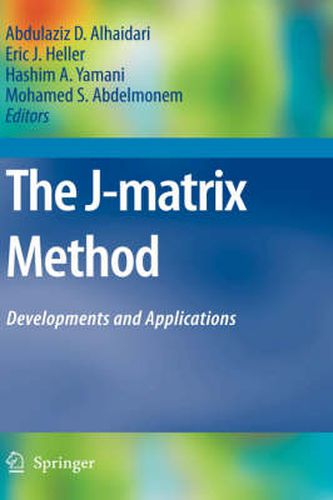Readings Newsletter
Become a Readings Member to make your shopping experience even easier.
Sign in or sign up for free!
You’re not far away from qualifying for FREE standard shipping within Australia
You’ve qualified for FREE standard shipping within Australia
The cart is loading…






This title is printed to order. This book may have been self-published. If so, we cannot guarantee the quality of the content. In the main most books will have gone through the editing process however some may not. We therefore suggest that you be aware of this before ordering this book. If in doubt check either the author or publisher’s details as we are unable to accept any returns unless they are faulty. Please contact us if you have any questions.
Although introduced30 years ago, the J-matrix method has witnessed a resurgence of interest in the last few years. In fact, the interest never ceased, as some authors have found in this method an effective way of handling the continuous spectrum of scattering operators, in addition to other operators. The motivation behind the introduction of the J-matrix method will be presented in brief. The introduction of fast computing machines enabled theorists to perform cal- lations, although approximate, in a conveniently short period of time. This made it possible to study varied scenarios and models, and the effects that different possible parameters have on the ?nal results of such calculations. The ?rst area of research that bene?ted from this opportunity was the structural calculation of atomic and nuclear systems. The Hamiltonian element of the system was set up as a matrix in a convenient, ?nite, bound-state-like basis. A matrix of larger size resulted in a better con?guration interaction matrix that was subsequently diagonalized. The discrete energy eigenvalues thus obtained approximated the spectrum of the system, while the eigenfunctions approximated the wave function of the resulting discrete state. Structural theorists were delighted because they were able to obtain very accurate values for the lowest energy states of interest.
$9.00 standard shipping within Australia
FREE standard shipping within Australia for orders over $100.00
Express & International shipping calculated at checkout
Stock availability can be subject to change without notice. We recommend calling the shop or contacting our online team to check availability of low stock items. Please see our Shopping Online page for more details.
This title is printed to order. This book may have been self-published. If so, we cannot guarantee the quality of the content. In the main most books will have gone through the editing process however some may not. We therefore suggest that you be aware of this before ordering this book. If in doubt check either the author or publisher’s details as we are unable to accept any returns unless they are faulty. Please contact us if you have any questions.
Although introduced30 years ago, the J-matrix method has witnessed a resurgence of interest in the last few years. In fact, the interest never ceased, as some authors have found in this method an effective way of handling the continuous spectrum of scattering operators, in addition to other operators. The motivation behind the introduction of the J-matrix method will be presented in brief. The introduction of fast computing machines enabled theorists to perform cal- lations, although approximate, in a conveniently short period of time. This made it possible to study varied scenarios and models, and the effects that different possible parameters have on the ?nal results of such calculations. The ?rst area of research that bene?ted from this opportunity was the structural calculation of atomic and nuclear systems. The Hamiltonian element of the system was set up as a matrix in a convenient, ?nite, bound-state-like basis. A matrix of larger size resulted in a better con?guration interaction matrix that was subsequently diagonalized. The discrete energy eigenvalues thus obtained approximated the spectrum of the system, while the eigenfunctions approximated the wave function of the resulting discrete state. Structural theorists were delighted because they were able to obtain very accurate values for the lowest energy states of interest.